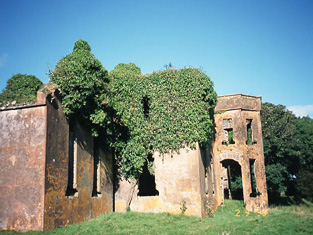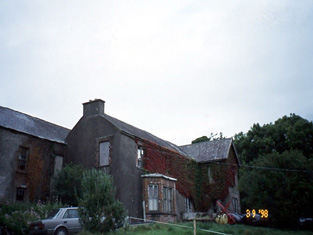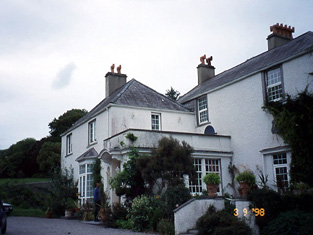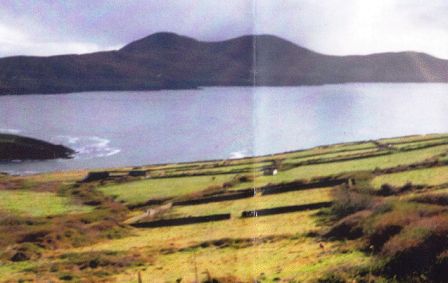Fermoyle Castle (Iveragh)
Houses within 10km of this house
Displaying 14 houses.
Houses within 10km of Fermoyle Castle (Iveragh)
Displaying 14 houses.
| House name | Description | |
|---|---|---|
| Carhan House | Maurice O'Connell held several properties at Carhan Lower, at the time of Griffith's Valuation, including a mill, valued at £18, which he was leasing to Patrick Trant. In the 1830s, the Ordnance Survey Name Books record that the mills had been built by Messers Trant and Barry c.1828. There were two other houses, one valued at £18, leased to James Barry, MD, and the second, valued at £6, leased to Rev. John Healy. Carhan House is named on the 1st edition OS map as "in ruins". Lewis notes "Cashen" as the old mansion of the O'Connell family in 1837. In the 1830s, the Ordnance Survey Name Books describe Carhan House as "a rectangular building, having a kitchen built up to the rere, all two stories high. The walls of its ruins are standing but in a state of dilapidation". The Irish Tourist Association Survey in 1943 described the original house as "in the shape of the letter T with the kitchen apartments nearest the river". In 1814 Leet refers to one property in Carhan as the residence of James O'Connell and to a second as the address of Miles McSweeney. |

|
| Castlequin | The representatives of Kean Mahony were occupying Castlequin at the time of Griffith's Valuation, when it was valued at £28 15s. In 1837 Lewis notes it as the seat of Kean Mahony. The Ordnance Survey Name Books, of 1840, mention that it had begun in September 1839 and was still being built. It is likely that this was a renovation of an earlier house. In 1894 it was the residence of Mrs.Mahony. In 1943 he Irish Tourist Association Survey mentions it having a chapel and library, "once the home of the McDonagh Mahonys, now in a derelict state and said to be distinguished by a ghost". Bary states that the house had probably been built in the late eighteenth century and continued to be occupied by the Mahony family until the early twentieth century when it was sold. It eventually fell into ruin in the 1940s. |

|
| Hillgrove | Lewis refers to Hillgrove as the residence of J. Primrose in 1837.In the 1830s, the Ordnance Survey Field Name Books described it as " a rectangular building with two wings, all two stories high and in good repair". Bary states that Hillgrove House was built by John Primrose, senior, agent to the O'Connell estate, in the early nineteenth century. It was being leased by John Primrose, (possibly son of the earlier John) to Denis Coughlan, at the time of Griffith's Valuation, when it was valued at £19 5s.The property was offered for sale in July 1854 in the Encumbered Estates Court when David O'Connor is recorded as the tenant at Hillgrove. Primrose was also a principal lessor in the parish of Caher at this time. Hillgrove is now demolished and much modern development has taken place in the area. | |
| Waterville | Caleb Chute was leasing a property valued at £18 to James Butler at the time of Griffith's Valuation. Both Lewis, in 1837, and Leet in 1814, noted Waterville as the residence of James Butler .The Ordnance Survey Name Books described it as " two stories high and in good repair" in 1840. Bary indicates that the house was built by the Butler family in the late eighteenth century and they resided there until 1965. It is now a luxury guesthouse with a golf links nearby. |

|
| Kineigh | Thomas Stoughton was leasing this property, valued at £10 15s, to John Fitzgerald at the time of Griffith's Valuation. In 1840, the Ordnance Survey Field Name Books indicated that it was the residence of Rev. George Hickson but had been built by John Hayes at the end of the eighteenth century. It seems to have become a Fitzgerald property later on. In 1894 Slater referred to it as the seat of John Francis Fitzgerald. The Fitzgerald family continued to reside there until the 1930s. The house is still extant. Adjacent to Kineigh House a site labelled "Donnall O'Sulivan's House (site of)" appears on both the 1st and 25-inch edition Ordnance Survey maps. |

|
| Aghagadda House | James O'Connell was in possession of this property, valued at £10 15s, at the time of Griffith's Valuation, when the house was vacant. In 1837 Lewis notes Ahadda as the seat of Rev. Mahony. Leet refers to Richard Mahony residing at Portmagee in 1814. Bary states that the house was built by the Mahonys who resided there in the early nineteenth century. It seems to have become the home of Charles O'Connell, son-in-law of Daniel O'Connell, for a time in the 1850s. Later it was occupied by members of the Spotswood family of Valentia. It is now a ruin. | |
| Aghanboy | Mary Bourke was leasing this property valued at £5 from Col. Thomas Bourke at the time of Griffith's Valuation. It is not named on the 1st edition map though buildings are shown. Leet records Ahanebee as the seat of Captain Burke in 1814. Buildings are still extant at the site. | |
| Waterview | Frederick Blennerhassett was leasing this property to Patrick Trant at the time of Griffith's Valuation, when it was valued at £6 15s. Both Lewis, in 1837, and Leet, in 1814, refer to it as the residence of P.Trant. Bary quotes O'Donovan that Waterview was built by Captain Trant in the early years of the nineteenth century. It remained a residence of the Trant family until the middle of the century when it seems to have been bought by the O'Connells. It was sold to the Moriarty family in 1927 and is still standing and inhabited. | |
| Kilkeaveragh House | Frederick Blennerhassett was leasing this property to Francis Chute at the time of Griffith's Valuation, when it was valued at £13. Lewis notes Kilkeaveragh House as the seat of Reverend J. Maunsel in 1837. Bary quotes O'Donovan who claimed that Francis Chute had built this house in 1836 but it is possible that he renovated an earlier property. The house is described as "in ruins" on the 1895 OS Map but there is a house labelled Seamount a short distance away, which Bary states was built by the Blennerhassetts and is still extant. Details of ground plan of Kilkeveragh House are held in the National Library of Ireland, Ms.13,631(7). | |
| Belville (Iveragh) | James Butler was occupying this property at the time of Griffith's Valuation, when it was valued at £9 15s. Both Lewis, in 1837, and Leet, in 1814, record it as the seat of Whitwell Butler. Bary states that it was probably built by Whitwell Butler in the late eighteenth century. In 1906 the property was owned by Arabella Butler and was valued at £8 5s. It continued to be used by the family until the end of the twentieth century but is now unoccupied and in poor repair. |

|
| Emlaghmore House | Thomas Smith was leasing this property from the Lansdowne estate at the time of Griffith's Valuation, when it was valued at £12 10s. Bary states that this house was associated with a branch of the O'Connell family, one of whom, Mary, married Daniel O'Connell. It later fell into ruin and nothing remains today. | |
| Valentia Slate Quarry | Berwick Blackburne was leasing the slate quarry and associated buildings at Dohilla, Valentia, from the Knight of Kerry at the time of Griffith's Valuation. The buildings were then valued at £26 15s. The quarry was opened by the Knight of Kerry in 1816 and contributed slate to many of the Victorian period's most farmous building projects, including the Houses of Parliament at Westminster. It closed in the twentieth century but was re-opened in 1998 and is still working. | |
| Glanleam | Glanleam was the home of the Knight of Kerry in Valentia. Tradition claims the property was first built in the eighteenth century as a linen mill, which was later remodelled as a house. In 1837 Lewis mentions it as the "beautiful seat of the Knight of Kerry". At the time of Griffith's Valuation, it was valued at £31. In 1906 it was still the property of the Knight of Kerry and valued at £75. In 1943 the Irish Tourist Association survey noted that it was the owned by Lord Monteagle. It is still extant and now operates as a luxury guesthouse, famous for its tropical gardens. |

|
| Ballynabloun House | In the 1850s this townland was held by Charles O'Connell, son-in-law of Daniel O'Connell. Local sources suggest he built this house around 1840. The house here was valued at £7 10s at the time of Griffith's Valuation. It was sold in the 1900s by Charles O'Connell's son, Daniel and thereafter demolished. The site of the walled garden is still visible. |

|

